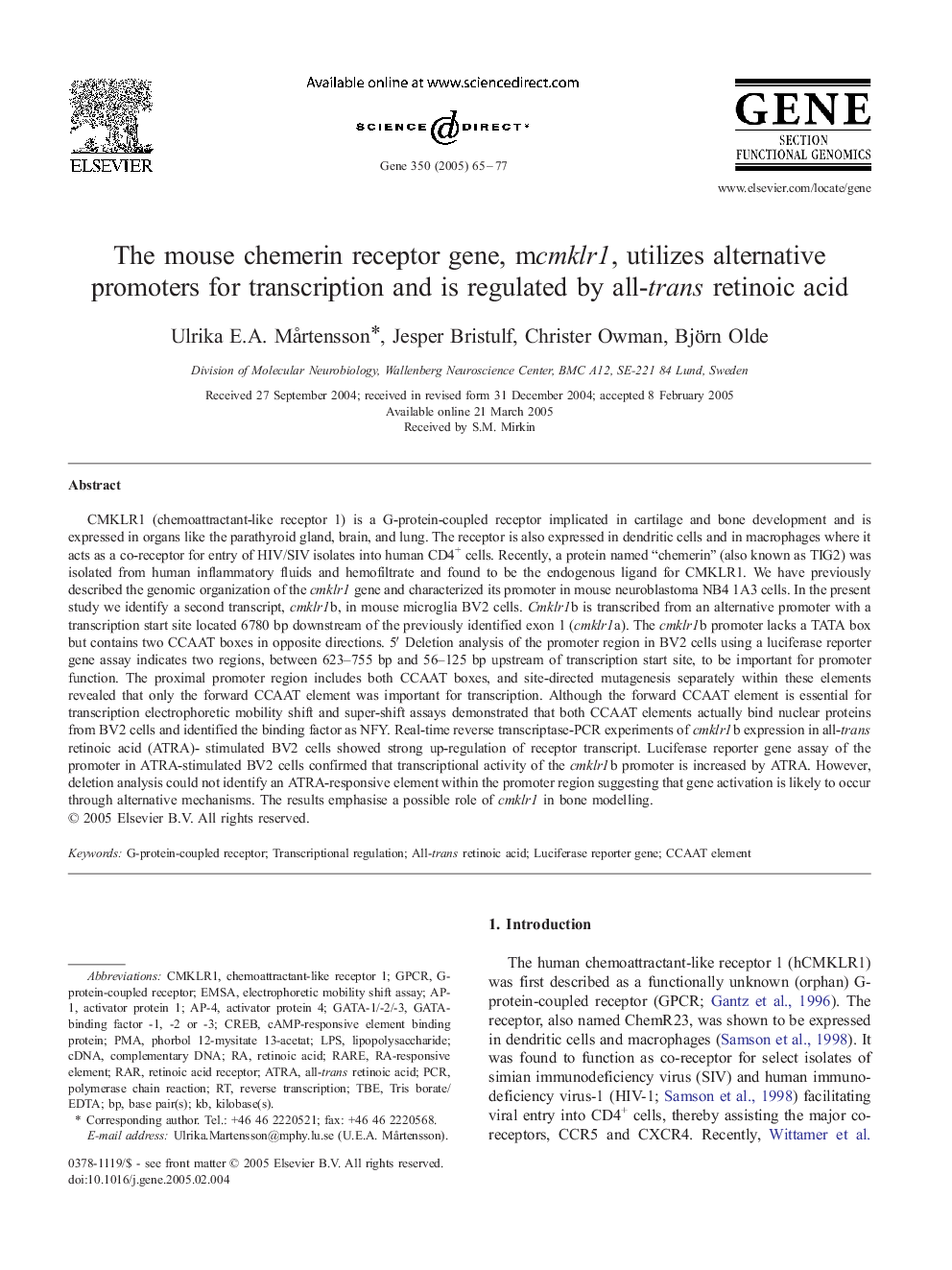| کد مقاله | کد نشریه | سال انتشار | مقاله انگلیسی | نسخه تمام متن |
|---|---|---|---|---|
| 9127138 | 1160201 | 2005 | 13 صفحه PDF | دانلود رایگان |
عنوان انگلیسی مقاله ISI
The mouse chemerin receptor gene, mcmklr1, utilizes alternative promoters for transcription and is regulated by all-trans retinoic acid
دانلود مقاله + سفارش ترجمه
دانلود مقاله ISI انگلیسی
رایگان برای ایرانیان
کلمات کلیدی
TBEEMSAAP-4CMKLR1RARCREBAP-1GPCRLPSatRA - ATRAcDNA - cDNAComplementary DNA - DNA تکمیلیG-protein-coupled receptor - G-پروتئین گیرندهPMA - LDC هاElectrophoretic mobility shift assay - آزمون تحرک تحرک الکتروفورزall-trans retinoic acid - آل – ترانس رتینوئیک اسیدTranscriptional regulation - تنظیم ترانزیتیBase pair(s) - جفت پایه (ها)Retinoic acid - رتینوئیک اسیدreverse transcription - رونویسی معکوسlipopolysaccharide - لیپوپلی ساکاریدRARE - نادرpolymerase chain reaction - واکنش زنجیره ای پلیمرازPCR - واکنش زنجیرهٔ پلیمرازcAMP-responsive element binding protein - پروتئین اتصال دهنده عنصر پاسخ دهنده cAMPactivator protein 1 - پروتئین فعال کننده 1Luciferase reporter gene - ژن خبرنگار لوسیفرازkilobase(s) - کیلو بایت (ها)Retinoic acid receptor - گیرنده اسید رتینوئیک
موضوعات مرتبط
علوم زیستی و بیوفناوری
بیوشیمی، ژنتیک و زیست شناسی مولکولی
ژنتیک
پیش نمایش صفحه اول مقاله

چکیده انگلیسی
CMKLR1 (chemoattractant-like receptor 1) is a G-protein-coupled receptor implicated in cartilage and bone development and is expressed in organs like the parathyroid gland, brain, and lung. The receptor is also expressed in dendritic cells and in macrophages where it acts as a co-receptor for entry of HIV/SIV isolates into human CD4+ cells. Recently, a protein named “chemerin” (also known as TIG2) was isolated from human inflammatory fluids and hemofiltrate and found to be the endogenous ligand for CMKLR1. We have previously described the genomic organization of the cmklr1 gene and characterized its promoter in mouse neuroblastoma NB4 1A3 cells. In the present study we identify a second transcript, cmklr1b, in mouse microglia BV2 cells. Cmklr1b is transcribed from an alternative promoter with a transcription start site located 6780 bp downstream of the previously identified exon 1 (cmklr1a). The cmklr1b promoter lacks a TATA box but contains two CCAAT boxes in opposite directions. 5â² Deletion analysis of the promoter region in BV2 cells using a luciferase reporter gene assay indicates two regions, between 623-755 bp and 56-125 bp upstream of transcription start site, to be important for promoter function. The proximal promoter region includes both CCAAT boxes, and site-directed mutagenesis separately within these elements revealed that only the forward CCAAT element was important for transcription. Although the forward CCAAT element is essential for transcription electrophoretic mobility shift and super-shift assays demonstrated that both CCAAT elements actually bind nuclear proteins from BV2 cells and identified the binding factor as NFY. Real-time reverse transcriptase-PCR experiments of cmklr1b expression in all-trans retinoic acid (ATRA)- stimulated BV2 cells showed strong up-regulation of receptor transcript. Luciferase reporter gene assay of the promoter in ATRA-stimulated BV2 cells confirmed that transcriptional activity of the cmklr1b promoter is increased by ATRA. However, deletion analysis could not identify an ATRA-responsive element within the promoter region suggesting that gene activation is likely to occur through alternative mechanisms. The results emphasise a possible role of cmklr1 in bone modelling.
ناشر
Database: Elsevier - ScienceDirect (ساینس دایرکت)
Journal: Gene - Volume 350, Issue 1, 25 April 2005, Pages 65-77
Journal: Gene - Volume 350, Issue 1, 25 April 2005, Pages 65-77
نویسندگان
Ulrika E.A. MÃ¥rtensson, Jesper Bristulf, Christer Owman, Björn Olde,